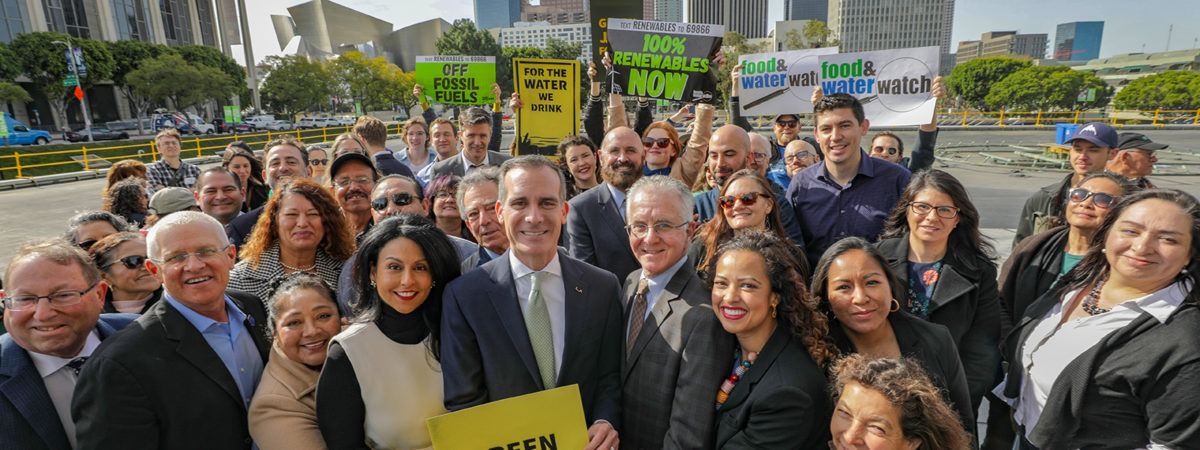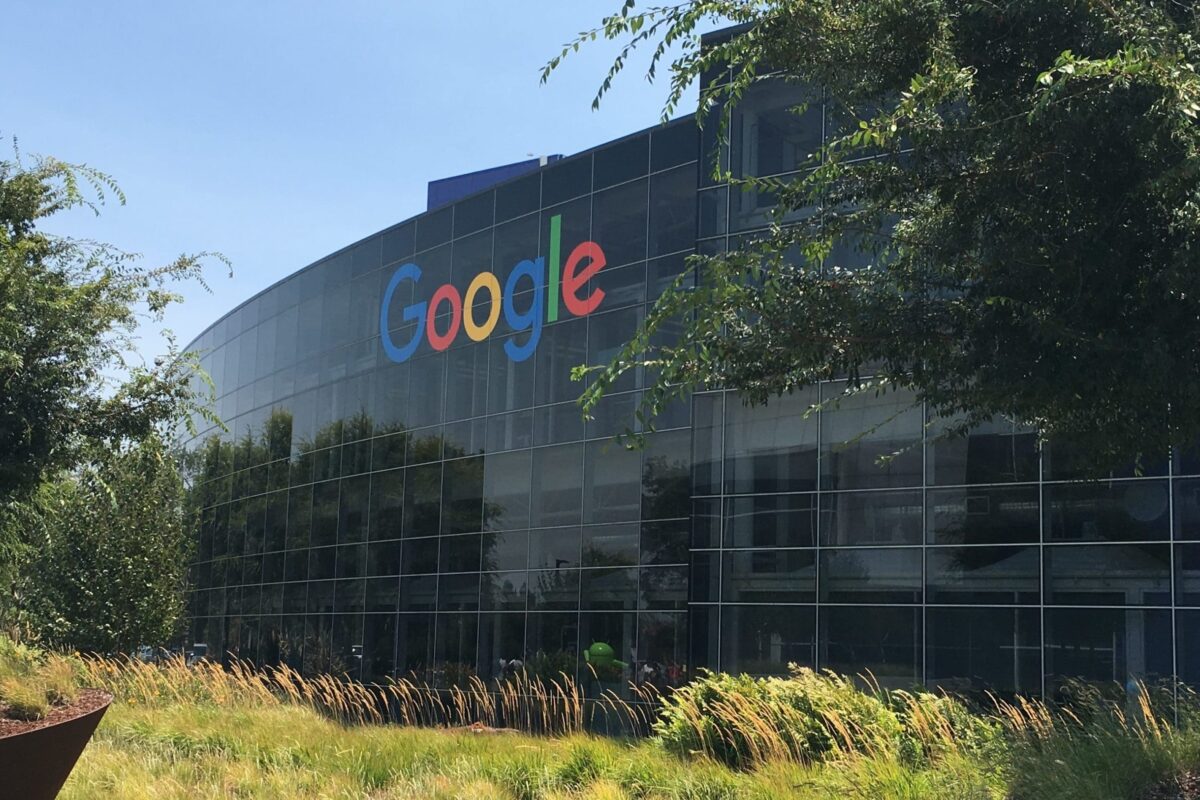Fox News and other right-wing media have done a good job of convincing the conservative base to oppose Alexandria Ocasio Cortez’ (D-New York) Green New Deal. However, the plan has not lost its magic in the blue states.
The Green New Deal has served to inspire policies from both presidential candidates and state leaders, but its most ambitious form yet may come at the city level. At least that is the bar that Los Angeles Mayor Eric Garcetti set yesterday with the roll out of a plan dubbed L.A.’s Green New Deal, whose 13 points cover everything from solar to single-use plastic, with a strong current of environmental justice and equity initiatives that shows the ideological inspiration of the original.
There’s far more to cover in the 151-page plan than any one article can do justice to, but among the top-line is an acceleration of the energy transition in electricity, with goals of 55% renewables by 2025 and 80% by 2036, and host of policies to enable a rapid build-out of local solar and energy storage.
This is not the only bold move; the plan also mandates that all new city-owned buildings and major renovations be all-electric, as well as setting a target for every single building in the city to become emissions-free by 2050 – with a major focus on electrification to meet that target.
Finally, the plan calls for an increase in the portion of electric and zero-emissions vehicles in the city to 25% by 2025, 80% by 2035 and 100% by 2050.
Catching up on renewables
Los Angeles’ new goal to reach 55% renewables by 2025 and 80% by 2036 is an acceleration on the state’s 60% by 2030 mandate, which is the third-most aggressive such policy at the state level.
But first the city has to catch up with the rest of the state, given that Los Angeles’ municipal utility procured only 30% of its electricity from renewables in 2017 – compared to an average of 36% by the state’s three large investor-owned utilities (PG&E, SCE and SDG&E), and 50% by the state’s community choice aggregators.
Additionally, while Los Angeles has the most raw watts of solar panels installed of any U.S. city, its per-capita numbers lag those of San Jose, San Diego and Riverside – the largest cities served by PG&E, SDG&E and SCE respectively.
The L.A. Green New Deal has a plan to address this, including targets for local solar, energy storage and demand response, as revealed in the table below:

This 1,950 MW of “local solar” will be nearly 5x as much as the 419 MW that was identified as serving Los Angeles at the end of 2018 by Environment America in its recent Shining Cities report; however, it was unclear if the 419 MW figure includes large solar outside the city or not. Either way, it is still less than is possible; a 2016 report by the U.S. Department of Energy’s National Renewable Energy Laboratory found that the city’s rooftops have the technical potential to host 9 GW of solar, or enough to supply 60% of its current electricity demand.
It’s notable that the plan’s energy storage targets are even more ambitious than its local solar targets, which may account for the fact that energy storage is going to be required to assist with helping imported renewables meet demand. This will be no small feat as the region gets to very high levels of renewable energy in its electricity supply – particularly in the winter, as unlike the rest of the nation wind does not produce more in the winter on the West Coast.
The plan has no shortage of policies to serve as means to enable all this new solar and storage, either. The plan intends to expand the city’s Feed-in Tariff, create new community solar programs for low income households and renters, launch a virtual net metering pilot program for multifamily housing and require that all new parking structures have solar – all by 2021.
Finally, the program hits an issue which has been identified by the California Solar and Storage Association (CALSSA) as a major stumbling block, with a target to maintain residential solar PV interconnection wait times at less than two weeks, as well as streamlining permitting and interconnection processes for energy storage.
Electrify everything
The portions of the plan dealing with buildings (point 4) and zero-emissions vehicles (point 7) also have implications for the transition in electricity, if for no other reason than that the plan will add significantly to the amount of renewable energy that must be deployed.
A press statement accompanying the plan made it clear that electrification will be a major means for decarbonization. One of the targets reads as follows:
Mandating that all new municipally owned buildings and major renovations be all-electric, effective immediately, and that every building in Los Angeles — from skyscrapers to single family homes — become emissions free by 2050.
And while it was harder to find this target spelled out in the plan, it does create a plan to study and incentivize building electrification. For transportation, the plan is also bold, and along with goals for transit-oriented development and improvement of public transit options, the L.A. Green New Deal calls for an increase in the portion of electric and zero-emissions vehicles to 25% by 2025, 80% by 2035 and 100% by 2050.
This includes a target to electrify the entire LA Metro and Los Angeles Department of Transportation bus fleet by 2030.
There is far more to this plan, which may be the most comprehensive plan to address climate issued by a city to date – even with stiff competition from Chicago Mayor Rahm Emanuel’s Resilient Chicago plan.
The implementation of L.A.’s Green New Deal will be something that we at pv magazine will be watching closely and covering.
This content is protected by copyright and may not be reused. If you want to cooperate with us and would like to reuse some of our content, please contact: editors@pv-magazine.com.









This plan by Mr. Garcetti Certainly seems very ambitious. As one who already drives an electric vehicle, a Tesla three, who owns solar panels provide the majority of energy to my own home I certainly do have a lot of questions for the city of Los Angeles and this green new deal.
According to the cities green new deal, there will be low income housing that is provided with solar electricity . Who gets this free public service first? In other words, only those that vote Democratic in the Ext election? Or perhaps those that actively campaign for the mayor the next time he runs for office?
I haven’t even gotten to what penalties will be applied to those buildings that have not been electrified via solar or wind. What are the penalties that will be applied to these properties in Los Angeles that have not converted over by 2025 etc?
Like AOC, The penalties for not going along with her program have not been discussed, nor voted on. All of a sudden a government bureaucracy will determine our future.
I have always thought that people would be more inclined to adopt these new technologies if they were incentivized to do so. In other words sell a program with honey and it’ll work well, sell a program with vinegar, and it’s doomed to fail. Whether you’re a Democrat, independent or Republican, let’s have The mayor provide us with some incentives, before he shoves His boot down our throats. Maybe some sort of tax relief for the building owner, or maybe a freeze in the amount of taxes paid to the city or county for 15 years.
Hello Carter,
I’ve noted that you have submitted several very long, politically charged comments on the pv magazine USA site.
While we do not shy away from discussing political subjects as they relate to renewable energy, your claims about free electricity going to those who vote Democratic are in the realm of conspiracy theories, and this makes me question whether or not the pv magazine USA site is the right place for your comments.
Christian Roselund
U.S. editor
pv magazine
Hello Christian,
You are correct and I apologize for musing about what might be happening.
From now on I will refrain from any politically charged comments or those that might be construed as being politically charged.
I do enjoy your magazine, and I will keep my remarks from now on To those that are specifically directed towards technology.
Carter
Thanks Carter.